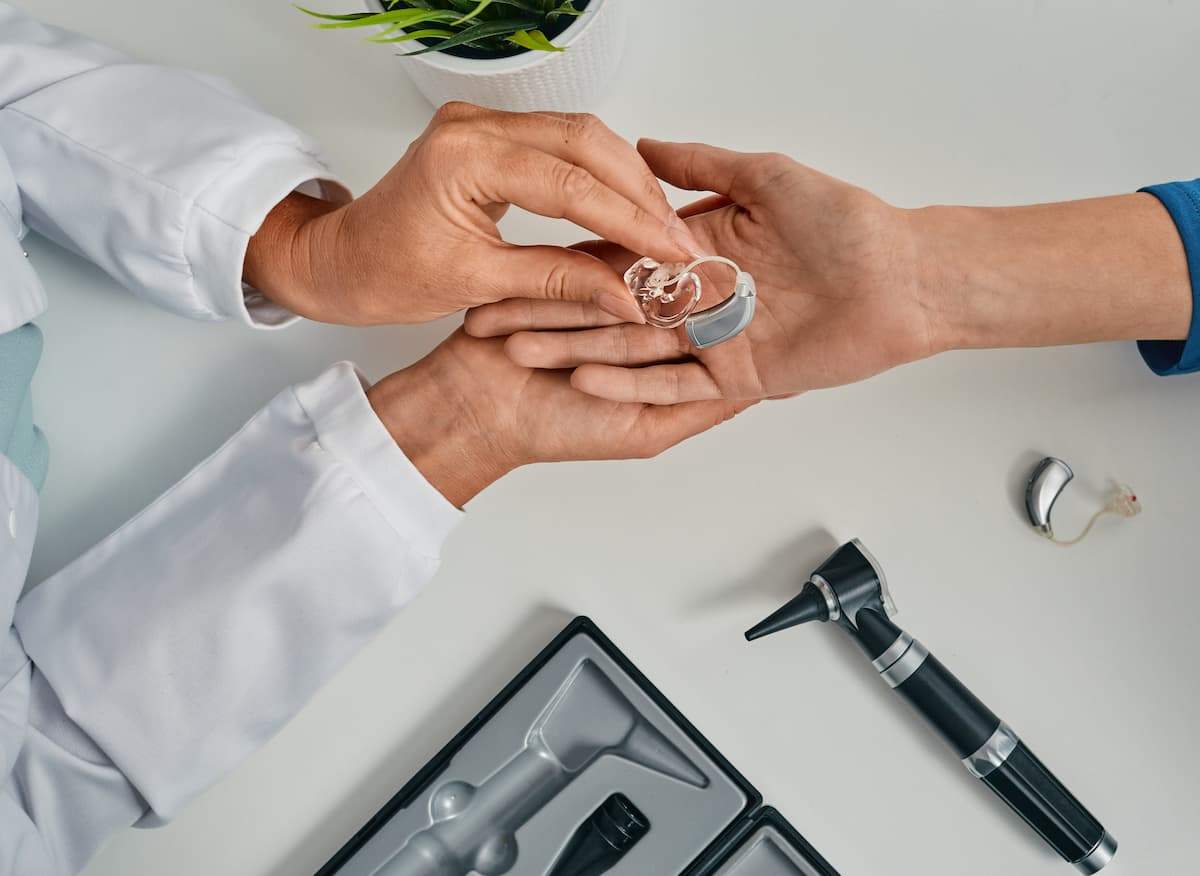補聴器を愛用する方にとって、音の明瞭さ、快適さ、そして長持ちのためには、補聴器を常に良好な状態に保つことが不可欠です。耳垢、ほこり、湿気にさらされる補聴器は、定期的なクリーニングとケアが必要です。このガイドでは、毎日のメンテナンスからメーカーごとのヒントまで、自宅で補聴器を適切にクリーニングする方法について、知っておくべきすべてのことをご紹介します。補聴器をできるだけ長く最高の状態に保つために役立ちます。
🚀 この投稿をナビゲート
以下もご興味があるかもしれません:
パート 1.補聴器のクリーニングがなぜ重要なのか?
補聴器は毎日耳垢、汗、ほこり、湿気と接触するため、音がこもったり、故障したりするなどの問題を引き起こす可能性があります。補聴器から耳垢やその他の汚れを取り除く方法を理解することで、音質を維持し、補聴器を快適かつ効果的に使用できます。
定期的なメンテナンスを無視すると、時間の経過とともに次のような問題が発生する可能性があります。
- 音質の低下: ワックスやゴミがスピーカーやマイクを詰まらせ、音の歪みや明瞭度の低下を引き起こす可能性があります。
- デバイスの損傷: 清掃せずに放置すると、湿気やゴミによって内部の部品が損傷し、補聴器の寿命が短くなる可能性があります。
- 皮膚の炎症: 蓄積した汚れや油は耳の周りの皮膚の炎症を引き起こす可能性があります。
では、補聴器を最適な状態に保つための最適なお手入れ方法は何でしょうか?適切な道具を使い、毎日数分のお手入れで、大きな違いが生まれます。
パート2.補聴器の掃除に必要な道具
補聴器を効果的に掃除するのに専門的な道具は必要ありません。シンプルなアイテムで十分です。必要なものは以下のとおりです。
- 柔らかく乾いた布:補聴器の表面の汗、ほこり、油などを優しく拭き取ります。
- 補聴器ブラシ:繊細な部分を傷つけずに耳垢やほこりを取り除くように設計された小さなブラシです。
- ワックスピックまたはループ: サウンドオープニングやマイクの周りなどの小さな隙間からワックスを取り除くためのスリムなツールです。
- クリーニング ワイヤー: 耳あな型 (ITE) 補聴器でよく使用されるこの細いワイヤーは、布やブラシでは届きにくい狭い場所にも届きます。
- 乾燥キットまたは除湿器: 湿気を除去するために不可欠です。湿度の高い環境に住んでいる場合や、運動中に補聴器を着用している場合に特に重要です。
これらのツールを使用して自宅で補聴器を掃除する方法を知っておくと、毎日のメンテナンスが迅速かつ簡単になり、常にクリアな音と快適な装着感を楽しむことができます。

パート3.補聴器をワイプで掃除できますか?
ワイプの使い方についてよくある質問があります。補聴器の掃除にベビーワイプを使ってもいいですか?それともアルコールワイプで補聴器を掃除してもいいですか?知っておくべきことは以下のとおりです。
- ベビーワイプ: 水分が含まれているため、時間の経過とともに補聴器に損傷を与える可能性があるため、推奨されません。
- アルコールワイプ:アルコールはプラスチックやシリコンを劣化させる可能性があるため、使用は避けてください。代わりに、補聴器専用のワイプか、乾いた布を使用してください。
湿気は電子機器の大敵です。問題を避けるために、ドライクリーニング方法を使用してください。
パート4.人気の補聴器ブランドのお手入れ方法
補聴器のブランドによって、お手入れの仕方が異なる場合があります。補聴器を良好な状態に保つための、ブランドごとのお手入れのヒントをご紹介します。
1. Cearvol補聴器
Cearvol補聴器は、快適さと使いやすさを重視して設計されています。Cearvol 補聴器の性能と寿命を保証するための詳細なガイドをご紹介します。
- 毎日の拭き取り: 毎日、柔らかく乾いた布を使用して補聴器の外側の表面を優しく拭き、汗、油、ほこりを取り除いてください。
- イヤーチップを取り外して清掃する: 定期的にイヤーチップを取り外し、適切なツールを使用して清掃し、蓄積した耳垢を除去します。
- 小さな隙間を掃除する: ワックス ループまたはクリーニング ワイヤーを使用して、マイクと受信機の近くにある小さな開口部からワックスを丁寧に取り除きます。
- 湿気コントロール: 運動後や湿気の多い環境での使用後は、乾燥ケースに入れて湿気を除去し、内部コンポーネントを保護します。

Diamond X1 - Bluetooth搭載の最高の補聴器
新人価格
249.99ドル309.99ドル
- ✔ クリアな聴覚を実現するアダプティブサウンド モード。
- ✔ 通話とストリーミング用の Bluetooth。
- ✔ アプリ制御のカスタマイズ可能な調整。
- ✔ 充電可能で急速充電。
- ✔ 軽度から中程度の難聴に最適です。
2. フォナック補聴器
フォナックの補聴器には、専用のクリーニング方法とツールが付属していることが多いです。フォナックの補聴器のクリーニング方法は以下の通りです。
- 表面のクリーニング: 毎晩、柔らかく乾いた布を使用してデバイスを拭き、油や汗を取り除きます。
- 耳垢の除去: 小さなブラシを使用して、サウンドポートとマイクの領域から耳垢を取り除きます。
- 充電接点を清潔に保つ: 充電式モデルの場合は、充電接点にほこりやごみが付着していないことを確認してください。
3. オーティコン補聴器
オーティコン補聴器は耐久性に優れていますが、定期的なお手入れが必要です。オーティコン補聴器のお手入れ方法は以下の通りです。
- 日常の拭き取り: 柔らかく乾いた布でほこりや油を拭き取ります。
- ワックス ブラシ: オーティコンの専用ワックス ブラシを使用して、スピーカーの開口部とマイクのポートを清掃します。
- 湿気を避ける: 水や湿気の多い洗剤は使用しないでください。必要に応じて夜間に除湿器を使用してください。
湿気の多い地域に住んでいる場合は、湿気の蓄積を防ぐために毎晩除湿器を使用することを検討してください。
4. フィリップスとリサウンドの補聴器
PhilipsとReSoundの補聴器は、乾いた布とワイヤーツールを使った定期的なクリーニングが最適です。PhilipsとReSoundの補聴器のクリーニング方法は以下の通りです。
- 毎日の清掃: 毎晩デバイスを拭いて、ワックスやほこりが付着していないか点検します。
- 狭い場所用のワイヤーまたはピック: クリーニングワイヤーまたはワックスピックを使用して、狭い場所からワックスを安全に除去します。
これらの手順に従うことで、詰まりを防ぎ、音質を維持することができます。
5. Jabra補聴器
Jabra補聴器には通常ワックスガードが付属しており、メンテナンスが容易です。Jabra補聴器のクリーニング方法は以下の通りです。
- 定期的な表面の拭き取り: 乾いた布を使用して、毎日外面を清掃します。
- ワックスガードメンテナンス: ワックスガードは 1 ~ 2 か月ごとに、または指示に従って交換してください。
- 湿気のチェック: 激しい運動中や湿度の高い環境で使用する場合は、除湿器を使用してください。
補聴器を初めて使用する場合は、 「補聴器を初めて使用する人のための 7 つのヒント」が、始める上で役立つ貴重な情報を提供します。
パート5.ワックスの蓄積に対処する方法
耳垢は耳を保護する天然物質ですが、補聴器使用者にとっては問題を引き起こす可能性があります。補聴器から耳垢を効果的に除去する方法を学ぶことで、音の明瞭度が大幅に向上し、機器の寿命も延びます。耳垢の蓄積に対処する手順は以下のとおりです。
- ワックスガードを使用する:多くの補聴器には、耳垢がスピーカーに届くのを防ぐための交換可能なワックスガードが付属しています。補聴器を清潔に保つために、数ヶ月ごとにこのガードを交換してください。
- 毎日ワックスをブラシで取り除く: ワックスブラシを使用して、サウンド開口部とマイクのポートからワックスを優しく取り除きます。
- クリーニングワイヤー:耳かけ型の場合は、クリーニングワイヤーを使って詰まった通路を掃除してください。損傷を防ぐため、過度の圧力をかけないようにしてください。
定期的に耳垢を除去すると、クリアなサウンドとデバイスへのフィット感が向上します。
パート6.補聴器と耳の掃除の頻度
補聴器と耳の衛生管理は、継続して行うことが重要です。タイムラインは以下のとおりです。
- 毎日:毎晩補聴器を拭いて、油分、ほこり、耳垢を取り除きましょう。これにより、目に見える問題がないか確認することもできます。
- 毎週:特に湿度の高い地域に住んでいる場合や、補聴器を装着中に大量に汗をかく場合は、除湿器を使用して補聴器を乾燥させてください。
- 毎月:ワックスガードまたはフィルターを交換して、音質を最適に保ちます。
耳の衛生のために、耳垢の蓄積を最小限に抑えるために、毎週耳掃除をしましょう。これは補聴器を清潔に保つだけでなく、耳詰まりのリスクも軽減します。

パート7.補聴器を良好な状態に保つための追加のヒント
掃除以外にも、次のような小さな習慣が補聴器の寿命を延ばし、良好な状態を保つのに役立ちます。
- 安全に保管する: 使用していないときは、補聴器を除湿器と一緒に保護ケースに保管してください。
- 湿気を避ける: シャワー、水泳、大雨など、水が関わる活動中は補聴器を外してください。
- 電池のメンテナンス:補聴器に使い捨て電池を使用している場合は、夜間は電池を取り外し、電池ケースを開けて空気に触れさせてください。これにより、電池の周りに湿気が溜まるのを防ぐことができます。
- 専門家によるクリーニング: 技術者は自分では届かない場所にも届くため、6 ~ 12 か月ごとに補聴器を専門家にクリーニングしてもらうことをお勧めします。
補聴器に関する詳しいアドバイスについては、当社の総合ガイド「補聴器について知っておくべきことすべて」をご覧ください。
結論
補聴器を定期的にクリーニングすることは、高品質な音と快適さを保つために不可欠です。これらの簡単な手順とルーティンに従うことで、補聴器の性能を最大限に引き出し、毎日よりクリアな音を楽しむことができます。毎日数分間のメンテナンスを行うことで、補聴器の寿命が延び、より効果的に機能し、周囲の世界とのつながりを保つことができます。




コメントを書く
全てのコメントは、掲載前にモデレートされます
このサイトはhCaptchaによって保護されており、hCaptchaプライバシーポリシーおよび利用規約が適用されます。